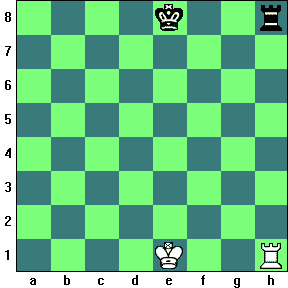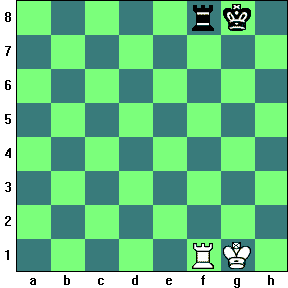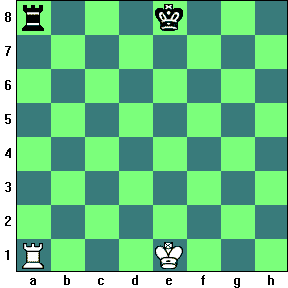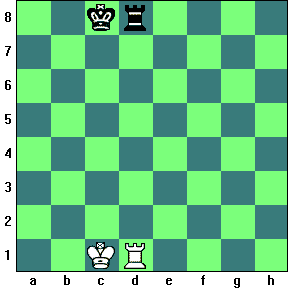|
Special Chess MovesThe special chess moves described in this article are only valid when no other piece is interfering. If any piece is in the way, then the moving piece can not skip over it. The moving piece can only move to any square before it in these special chess moves. If it is an enemy piece, it can also be captured. To capture the opponent's piece, one moves his own to the enemy piece's square, then removes the enemy piece from the board (It is good to capture enemy pieces because opponent's strength is reduced as a result). For example, suppose a white Queen is positioned on a1 (Qa1) and a black Bishop is placed on d4 (Bd4). If it is WHITE'S move, he can capture the Bd4, provided the squares b2 and c3 are empty; to do this, he removes the enemy bishop and places his queen on d4. We denote this move by 'Qa1 x d4' (or simply 'Qxd4'). This means 'The Queen at a1 captures (something) at d4'. If there was no capture we would write 'Qa1 - d4' (or simply 'Qd4'). There are some exceptions to the basic rule regarding captures. A pawn can not capture pieces positioned on the square(s) the pawn can advance to; instead it may capture an enemy piece that is placed one square diagonally and in front of it. For example, suppose WHITE has a pawn located at e2. The pawn can move both to e3 and e4 if no piece interferes, but it can not capture on these two squares. Instead it can capture on d3 or f3. A special case of pawn capture exists when moving the pawn two squares forward (remember this is only possible if the pawn is still on its initial position). In this case an enemy pawn that would have been able to capture it, had it moved only one square instead of two, is still able to capture it. This capture is called 'en passant' and it is only valid for one move : if the player who may capture 'en passant' does not use this right in his next move, he will no longer be able to do it later. For example, if WHITE moves his e2-pawn (Pe2) to e4 (we write this move as 'e2-e4' or simply 'e4') and there is a black pawn at d4 (Pd4), then BLACK is able to capture en-passant ('Pd4xe3 e.p.' or simply 'dxe3'), just as if the white pawn had moved to e3. But if he decides to play something else, he no longer retains this right. A King can not be captured. In effect, the King can not move to a square controlled by an enemy piece; so there never arises such a case. We say a square is 'controlled by a piece' if the piece can capture on this square. Also note that, regarding a Knight's move, there are no interfering friendly or enemy pieces; the Knight can always land to its destination square. A pawn that manages to traverse all the way to get to the other side is 'promoted'. When a promotion happens the player replaces the pawn with a same-coloured piece of his choice (King and Pawn excluded). In most cases pawns are promoted to Queens.
Castling may be either 'short' or 'long'. Consider the white King on e1 (Ke1) and the white Rook on h1 (Rh1). 'Short castling' involves moving the King to g1 and simultaneously the Rook to f1. The picture on the left illustrates the position of the pieces before Short Castling move The whole procedure is considered to be one single move, not two (we denote short castling by 'O-O').
However, there are some constraints before one can castle : both the King and the Rook must have not moved before. In addition, all in-between squares must be empty and both landing squares (f1 and g1 in the example) must not be threatened by the enemy pieces. In addition, the King must not be in check. If all these apply, one may castle. Long castling (denoted by 'O-O-O') is similar, the only difference being that the a-Rook is used instead.
The picture on the left indicates the position of the chess pieces before the Long Castling move takes place All the same applies for BLACK too, the corresponding squares being g8 and f8 for short castling and c8 and d8 for long castling.
The picture on the right indicates the position of the pieces after the Long Castling move has taken place. The game starts always with WHITE to move and players taking turns. Moving a piece is obligatory, one cannot 'pass'. The player who checkmates his opponent is the winner. There can also be a draw. This happens when no side has enough material to checkmate their opponent. If, for example, WHITE is left with the King and a Bishop and BLACK with only his King, there is no way that WHITE can checkmate BLACK and the game is drawn. A draw may also be agreed at any time. Other draw cases include the 'triple repetition' of the same position, the '50 moves rule' (game is drawn if no pawn advance or capture has taken place during the last 50 moves) and 'stalemate'. A player is stalemated if he has no valid moves, but he also is not in check. Recall that when one is in check and has no valid moves, he is 'checkmated' and he loses the game. Finally, a player who is able to be checking his opponent for as long as he wishes, may claim draw by 'continuous check', a special case of the 50 moves rule. To read more about chess and how to play well, you can return to the Chess Homepage, by clicking here
|





 The King has also a special move at his disposal. It is called 'castling' and is a defensive move, used to increase the King's safety.
The King has also a special move at his disposal. It is called 'castling' and is a defensive move, used to increase the King's safety.  The
picture on the right illustrates the position of the chess
pieces after the Short Castling move.
The
picture on the right illustrates the position of the chess
pieces after the Short Castling move. The ending squares are c1 for the King and d1 for the Rook.
The ending squares are c1 for the King and d1 for the Rook. 